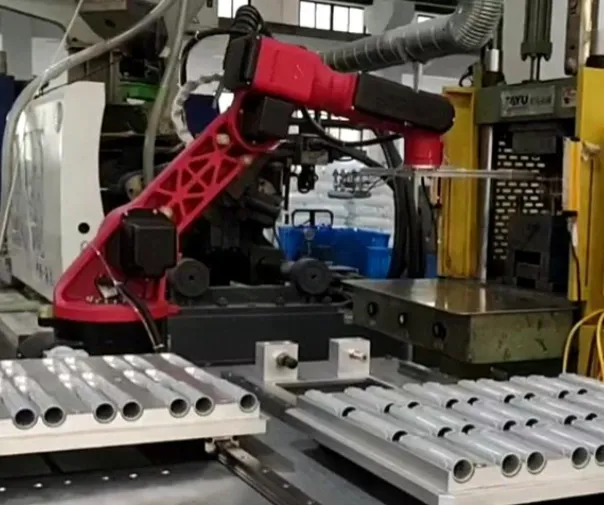In the world of industrial robotics, grease plays a crucial role in maintaining optimal performance by reducing friction, minimizing wear, and ensuring smooth operation over time. Proper lubrication is essential to prevent failures and extend the lifespan of robotic systems. However, when grease issues arise, they can cause significant disruptions, downtime, and costly repairs.
Robots often work in demanding environments, performing repetitive tasks with high-speed movements and heavy loads. Over time, these conditions can cause the lubrication system to deteriorate, leading to issues such as leaks, hardened grease, or breakdowns. It’s important for maintenance professionals to be able to identify and address these problems before they impact productivity.
In this post, we will discuss common grease-related problems in robots, their causes, and the steps you can take to troubleshoot and fix them. With proactive maintenance, you can avoid costly repairs and keep your robotic systems running smoothly.
Diagnosing Robot Grease Problems: Key Inspection Steps
The first step in diagnosing grease issues is a thorough visual inspection. Look for the following signs:
- Grease Leaks: Leaks around joints, seals, or lubrication points often indicate over-lubrication or seal failure.
- Hardened Grease: Grease that has become crusty, flaky, or solidified no longer functions properly. This can lead to increased friction and premature wear on moving parts.
- Contaminated Grease: If the grease appears discolored, gritty, or contains dirt and moisture, its effectiveness is compromised, and it may accelerate wear on the robot.
- Uneven Grease Distribution: If lubrication points are clogged or improperly maintained, grease may not be distributed evenly, leading to wear in some areas while creating excess buildup in others.
Checking Grease Consistency
To evaluate whether the grease is still functional, check its consistency. Signs of degradation include:
- Grease becoming too thick or too thin.
- Separation of grease into oil and solid components.
- Increased resistance or difficulty moving robotic joints, which indicates inadequate lubrication.
Troubleshooting Common Grease Issues in Robots
A. Grease Leaks: Causes and Solutions
Why does grease leak?
- Over-lubrication: Applying too much grease can build up pressure, leading to leaks.
- Damaged Seals: Worn or defective seals may allow grease to escape.
- Clogged Grease Fittings: If grease cannot reach the intended lubrication points, it may escape from other areas.
Solutions:
- Inspect and replace damaged seals to prevent further leaks.
- Follow manufacturer guidelines for the proper amount of grease to apply.
- Clean or replace clogged grease fittings to ensure proper grease flow.
B. Hardening of Grease: Causes and Solutions
Why does grease harden?
- Incompatible Greases: Mixing different types of grease can cause thickening or hardening.
- Exposure to High Temperatures: Heat can dry out grease, causing it to lose its effectiveness.
- Aging Grease: Over time, grease can solidify if not reapplied regularly.
Solutions:
- Flush out old grease and replace it with a compatible lubricant recommended by the manufacturer.
- Use high-temperature-resistant grease for environments with extreme heat.
- Standardize the grease types across all robots to prevent mixing different formulations.
C. Grease Breakdown: Causes and Solutions
Why does grease break down?
- Incorrect Grease Type: Using grease that isn’t recommended can lead to premature degradation.
- Contamination: Dust, moisture, and metal shavings can accelerate grease breakdown.
- Excessive Workload: High speeds and heavy loads can stress the lubrication, causing it to degrade more quickly.
Solutions:
- Always use the grease recommended by the manufacturer for your specific robot model.
- Check for contamination and improve sealing or filtration systems if necessary.
- Adjust lubrication schedules based on the robot’s workload and operating conditions.
Cleaning vs. Replacing Grease
When to Clean or Replenish Grease
- If the grease is slightly contaminated but still retains proper viscosity.
- If the lubrication has gradually depleted and needs replenishment.
- During routine maintenance, as part of scheduled grease checks.
Steps for Cleaning or Replenishing:
- Wipe off old grease from joints and fittings.
- Apply the recommended amount of fresh grease to the lubrication points.
- Ensure all points are evenly covered.
When to Fully Replace Grease
- If the grease has hardened or separated into oil and solid components.
- If there is significant contamination (e.g., dust, moisture, or metal particles).
- If seals have failed, leading to excessive grease loss.
Steps for Full Replacement:
- Remove all old grease using compressed air or an approved cleaning solvent.
- Replace seals if necessary.
- Apply fresh grease according to manufacturer recommendations.
Preventative Maintenance Tips
- Regularly Inspect and Maintain: Follow a maintenance checklist to ensure lubrication systems are functioning properly. Keep detailed records of maintenance activities to track grease performance over time.
- Avoid Over or Under-Application: Use grease guns correctly to apply the right amount of grease. Over-lubricating can lead to leaks, while under-lubricating can cause excessive friction and wear.
- Proper Grease Storage: Store grease in a cool, dry place away from direct sunlight to prevent it from degrading before use.
- Early Issue Detection: Train technicians to spot early signs of lubrication failure, such as unusual noise, increased friction, or jerky movements.
- Use Predictive Maintenance Tools: Implement sensors or monitoring systems to detect early lubrication issues before they lead to significant damage.
- Standardize Grease Types: To prevent compatibility issues, use the same type of grease across all robots in a facility, simplifying inventory management and reducing the risk of mixing incompatible greases.
Conclusion
Maintaining proper robot lubrication is critical to ensuring smooth operation, preventing grease-related failures, and avoiding costly repairs. By understanding common grease issues, their causes, and how to troubleshoot them, maintenance teams can minimize downtime and extend the lifespan of robotic systems. Regular maintenance, correct grease application, and the use of preventive measures will help keep robots running efficiently for years to come.







